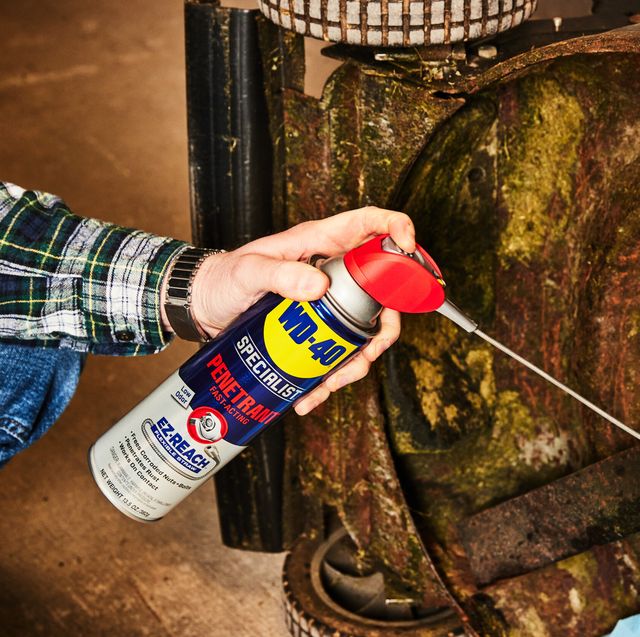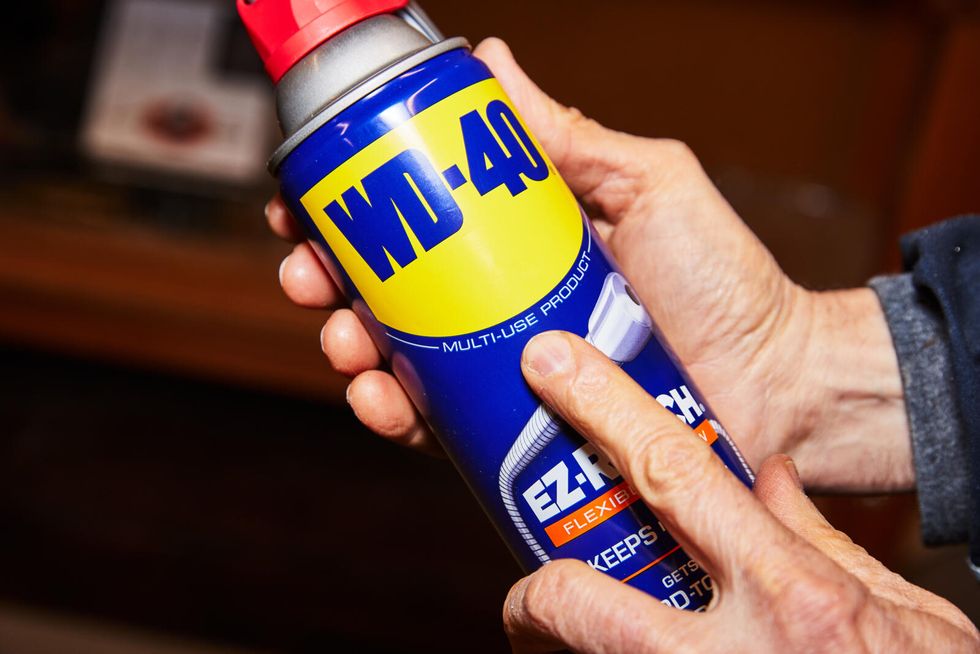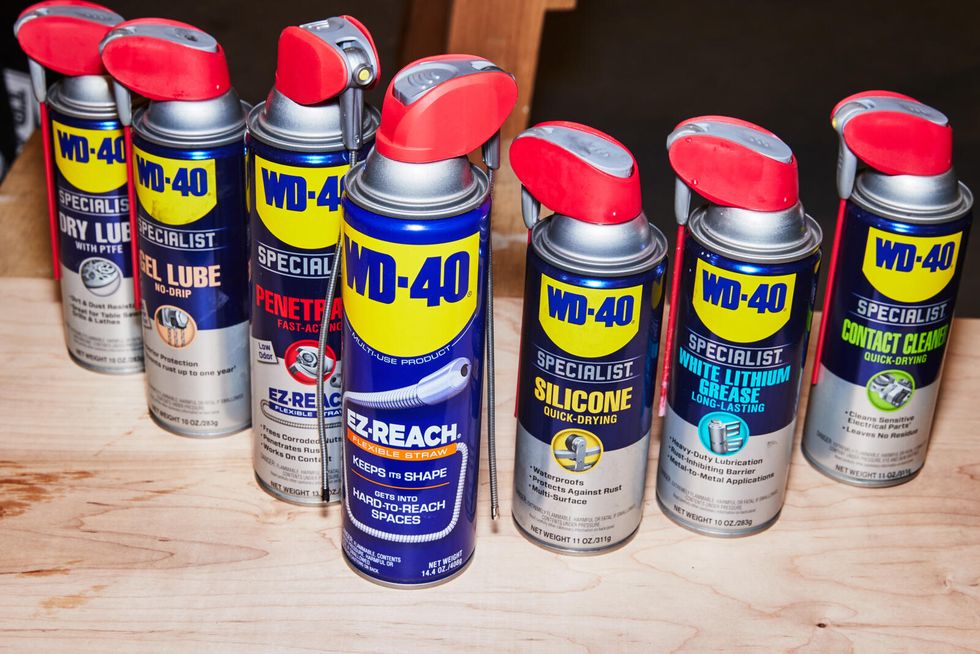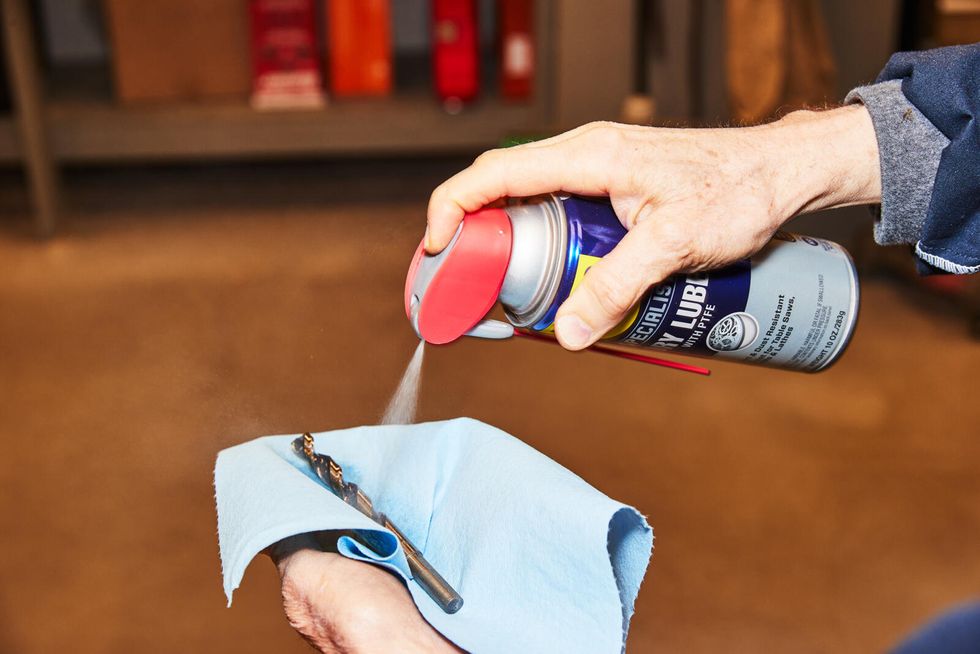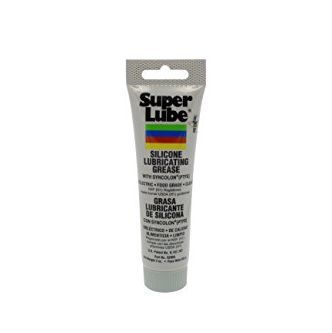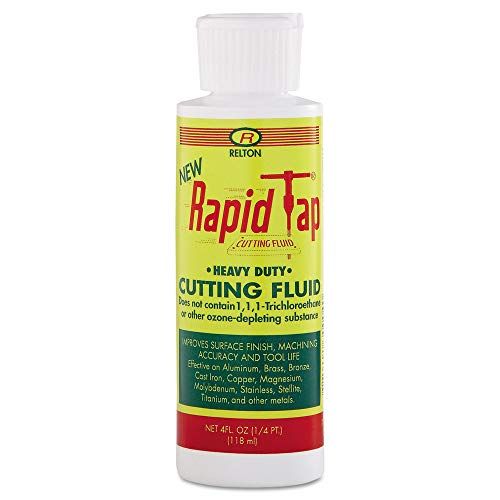WD-40. For many people, the name means lubrication. A hinge squeaks or a bolt sticks in its hole, you give it a shot from the familiar spray can.
The lubricant is as close to ubiquitous as these materials can be. All over this country, it’s stashed in kitchen drawers, car trunks, on garage shelves, in tool boxes, on workbenches, and in maintenance carts on factory floors. It’s sold nearly everywhere: hardware stores, farm-supply stores, and in supermarkets. You can buy a spray can as small as 3 ounces or a 55-gallon drum of the liquid ($1,687).
We have nothing more than anecdotal evidence to make this claim, but aside from engine oil, it may be the most widely used lubricant in the United States. The company states something like 2,000 uses for its flagship spray, everything from silencing squeaky hinges to freeing a python wrapped around the undercarriage of a bus. Police even used it once to grease down a naked burglar who got stuck as he squirmed his way into a building via an air conditioning duct. This is the WD-40 which its label identifies simply as “Multi-use Product.” Not oil. Not corrosion inhibitor. Not penetrant. Below that disarmingly-simple title, the can text reads, “stops squeaks, removes and protects, loosens rusted parts, frees sticky mechanisms, drives out moisture.”
If the product had been developed a generation after its 1950s launch, it would have been a natural for TV infomercials.
As good as WD-40 is, it can't do everything. No lubricant can. That is the basis of this story. There’s a lot more to lubrication than a shot from a spray can that you keep in the kitchen cabinet. Aside from the most familiar form of WD-40, there are a lot of other products that excel at specific jobs and there are many variations of WD-40 other than the ubiquitous multi-use version. Below, we recommend a handful of products after years of experience using them.
A History Lesson
The now iconic brand takes its name from its formulation. WD-40 stands for Water-Displacement 40, a thin-film lubricant that displaces moisture and was perfected on the 40th attempt. Three employees of the Rocket Chemical Company in San Diego formulated the blend in 1953, and it soon found large scale commercial success as a corrosion protection coating applied to the skin of Atlas missiles.
The flagship formulation is a blend of high-quality, light-body lubricating oils propelled out of the can with CO2. The company added a light fragrance in 1961, and that's about as close as it ever came to doing anything strange with it. Its formulation is so closely guarded that it was never patented, and the MSDS that describes it is barely helpful for identifying the contents in the can. The company stores the formula not in its headquarters in San Diego, but in a bank vault nearby.
A long list of commercial successes followed those humble beginnings, leading the company to where it is today, a publicly-traded entity with stock trading in the vicinity of $171.50 per share. It’s a small but commercially important cog in the lubrication industry, a market worth nearly $19 billion annually.
That gigantic lubrication market, and the brand’s strong acceptance among users, explains why the company makes more than its most familiar lubricant. Its catalog lists 22 products each available in a range of sizes and applicator types. In all, these various formulations encompass general spray lubricant, industrial grease, bike chain lube, roller chain lubrication, rust removers, and a variety of cleaners. It’s all related: cleaning, lubrication, and corrosion protection.
Understanding Lubrication
Lubrication is notoriously complicated. Parts in motion relative to one another make physical contact causing sharp microscopic pieces of material to be broken off. These jagged particles tumble around, further increasing the friction between the parts, increasing heat and accelerating surface damage. In turn, this causes more particles to break free and the damage cycle repeats itself and is magnified until one or both parts fail. Lost in history, people discovered that placing tallow or wax between the parts helped them interact with less damage.
It seems that early on in WD-40’s history people understood one thing about it: It’s easy. Something needs lubrication? Grab the spray can and hose it down. What’s more, it’s even pleasant. It doesn’t stink. Nothing smells offensive when you’re done. Not you. Not the part. Plus, it’s easy to find. The can’s graphics make it jump out in a cluttered workshop. And, it’s easy to buy. When the can runs out, pick up another one at the grocery store–or seemingly at any store.
Maybe it’s a little too easy, leading people to use the standard product when they should be using something else. Therein lies a problem.
Lubrication is a highly specific business, according to Chris Aiello, a senior scientist in research and development at the company’s technical center in Pine Brook, New Jersey. “While the WD-40 Multi-Use Product is viewed as a ‘one-can wonder’ by many people, we also heard from our end users that they have specialized needs for specific pain points.”
Given the complexity of the topic, I asked Aiello if lubrication could be condensed to three, bite-size pieces of advice. He gave me these three:
Start with a clean surface
“It can be tempting to pull out a spray can and get to work,” says Aiello, “but cleaning a surface before lubricating is important because contaminants can degrade lubrication, making it less effective.”
Dirt, rust, and particles of loose paint are all abrasive substances. Obviously, if you want lubrication to perform at an optimal level, you need to remove these. Clean first, then lubricate.
Surface type matters:
“A multi-purpose lubricant works well on metal surfaces,” Aiello says, “but materials such as plastics and rubber require special lubricants with compatible additives.”
See our section below on lubrication additives.
Specifications are important
“Everyone loves the idea of a ‘one-can wonder’ but not all lubricants are the same,” Aiello counsels. “Select the lubricant based on the surface material, the kind of load you expect the lubricant to see, temperature, humidity, and even the position of the parts in service—such as whether the lubricant will be applied on vertical surfaces, horizontal surfaces, or whether the lubricant will have to cling to the bottom of a horizontal surface. All of this matters.”
Read the text on the lubricant’s container and look up technical documents that you can download from the manufacturer’s websites, Aiello advises. This data is more than self-serving product hype, he points out. Reputable products are rigorously tested in a laboratory to meet industrial and other specifications, such as those formulated by the American Society for Testing and Materials (ASTM). “Look for specifications and ASTM performance data to get a more precise idea of how the lubricant has been tested and what it’s formulated for,” says Aiello.
Lubrication Additives
Most lubricants consist of a base oil and additives that improve its performance. Perhaps no other aspect of lubrication is as tricky as selecting a lubricant based on these additives. People shopping for lubrication will notice the addition of silicone, PTFE (Poly Tetra Fluoro Ethylene; Teflon is one form of this), molybdenum disulfide and molybdenum diakyl dithio carbamate (either of them are simply called “moly”), copper, white lithium, zinc, and graphite.
Additives play any number of roles in a lubricant, according to Aiello. They can thicken it so it clings to vertical surfaces while helping it withstand exposure to the elements (white lithium). Other additives, such as silicone, lubricate plastics and rubber while not dissolving them. The addition of “moly” helps to lubricate metal-to-metal surfaces where there is extreme pressure and heat. The addition of copper to a lubricant helps threaded parts turn freely while resisting galling—a phenomenon where metal particles are broken loose only to reattach themselves to an adjacent surface in a process known as cold welding.
Some of these additives are solids that interact physically with the surface, other additives are chemicals. A good way to think of solid additives is that they are like molecular ball bearings, or in some cases platelets, that contribute to the free movement of parts relative to one another. Chemical additives may improve the lubricant’s performance in other ways, such as helping to fight corrosion or increasing fire resistance.
As a group, says Aiello, lubricating oils that contain additives are considered “high performance” relative to lubricants that lack them. Sure, you may pay more for these formulations, but the performance benefits they provide are worth it.
Some of Our Other Favorite Lubes
While WD-40 works well in many cases, there are other specialized lubricants we reach for in certain situations. Here are some of our top
Super Lube is a blend of silicone and ultra fine particles of PTFE (Teflon is DuPont’s version of this). It’s the slipperyest grease I know of. I keep a tube in my tool kit and use it whenever it’s important to make a part slide or turn. A tiny dab of it goes a long way. I find a single tube will last a couple of years before it needs to be replaced.
Drilling, tapping, and sawing are easy enough in a machine shop where you are using machine tools and gallons of cutting fluid. Life isn’t so soft out in the field, where you may be drilling into cast iron, cutting thick pieces of steel with a hacksaw or a reciprocating saw, or tapping holes in anything from carbon steel to stainless steel. Some years ago, tired of dulling drill bits and getting taps stuck, I stumbled onto Relton’s Tap Magic and haven’t looked back. The 4-ounce size is perfect around the shop, and I get a year of use out of this size. If I have a big metal project, I can always switch to the pint or even the gallon size.
Dry Lube is just that. It starts out as a liquid and dries to a microscopically thin but slippery layer. Apply a little bit of this liquid lubricant to drill bits, miter gauge slots, the blade of combination square or any metal surface that you want to keep clean and sliding freely (keys are another one!). And there you have it, a properly lubricated surface with a dry film. The effect is particularly noticeable with drill bits and taps. Cutting fluids work even better on these pre-lubricated surfaces. It takes a few minutes of time and the performance improvements are easily worthwhile.
..
Roy Berendsohn has worked for more than 25 years at Popular Mechanics, where he has written on carpentry, masonry, painting, plumbing, electrical, woodworking, blacksmithing, welding, lawn care, chainsaw use, and outdoor power equipment. When he’s not working on his own house, he volunteers with Sovereign Grace Church doing home repair for families in rural, suburban and urban locations throughout central and southern New Jersey.
